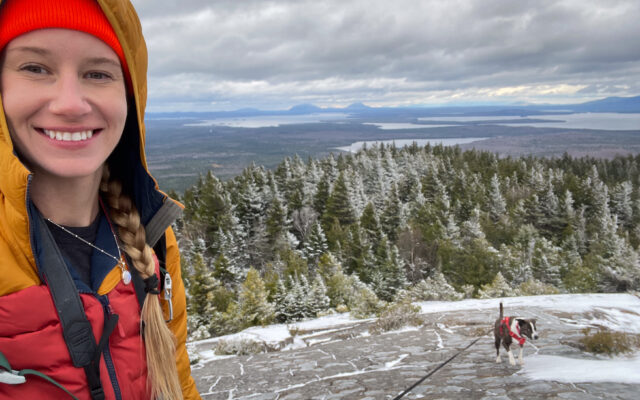
Here’s one of the most challenging things about winter hiking
By Aislinn Sarnacki
A friend of mine went hiking on a cold, blustery day in late November, and relayed to me a challenge.
At first, she was cold. As she hiked the mountain, she became hot. At the top of the mountain, exposed to the wind, she cooled off again. Then, on the way down, it felt as if frost was creeping into her bones.
I can relate to her frustration. After winter hikes, I often take a bath to thaw out. It’s easy to fall victim to the cold.
Yet, when wearing all my winter hiking clothes — the insulated pants, wool base layer, down jacket, fleece-lined hat and waterproof mittens — it’s also easy to overheat, especially when laboring uphill.

WINTER WEAR — Aislinn Sarnacki takes a selfie while hiking up Eagle Rock with her dog, Juno, on Nov.11, in the Moosehead Lake Region. She’s wearing a down jacket to protect herself from the cold wind that’s whipping over the exposed bedrock.
This yo-yoing of body temperature is a bit of a conundrum. I find that it’s one of the greatest challenges of winter hiking.
The solution sounds simple, and perhaps you’ve heard it before: Dress in layers. But it’s a bit more complicated than that.
What does it mean to dress in layers? I interpret it this way: Instead of relying on just a thick coat and snow pants for warmth, you should pile on multiple, thinner layers of clothing.
That way, you can take off layers as you warm up as a way of regulating your temperature.
I start with a base layer, also known as thermal underwear or long johns. These are made with wool or synthetic materials, not cotton.
In fact, avoid wearing any cotton clothing. It holds onto moisture, such as sweat, which can rapidly cool your body.
Sweat is a real problem when winter hiking. You want to avoid it, which is a tall order when clambering up a snowy slope. That’s why it’s so important that you can take off layers as you warm up.
I can recall a handful of times when I became so hot during a winter hike that I took off my coat and hiked in a T-shirt for a while.
I also regulate my temperature by taking off my hat or mittens to let heat escape.
The layers you wear on top of your base can vary, depending on your preferences and the weather. I often wear a fleece jacket, or thin down jacket, or both. Some people prefer wool coats or sweaters.
For pants, I wear insulated hiking pants, fleece-lined leggings or snow pants.
A waterproof and windproof jacket is a great final layer. And on colder days, I bust out my thick down jacket.
Prior to becoming a winter hiker, I’m not sure I would have believed you if you had told me that sweating and overheating could be such an issue. But I would have believed that the cold could be a problem.
Hypothermia is one of the top threats to recreationists in Maine, year round. During the winter, that risk is even higher.
When hiking or snowshoeing, I find that I cool down quickly when I stop for a snack. So I try to keep my breaks short, or I eat and drink on the move.
I also avoid sitting on the frozen ground or in the snow for too long.
It’s amazing how much shelter and warmth a forest can provide. But once out of the forest, on an open mountain ridge or even an open field, the wind can quickly turn you into an ice cube if you aren’t careful.
If I know I’m nearing an area that’s exposed to the elements, I put on my warmest layers.
What you wear on your head, hands and feet can make a huge difference in terms of warmth and comfort. Everyone has their preferences.
Just keep in mind that not all outdoor winter accessories are created equally. For example, some knit hats, while perhaps adorable, are too thin and holey to offer much protection.
For that reason, I prefer dense wool or fleece-lined hats.
Packing extra clothing is always a good idea. If I know that I’m going to sweat a lot during a strenuous hike, I’ll pack a shirt to change into near the top of the mountain.
Extra socks are great, too, and can double as mittens in a pinch (say if you lost a mitten in the snow, which I have done).
With all this clothing — plus winter boots, gaiters, ice cleats, snowshoes, balaclavas and other gear — outfitting yourself for the season can become pricey.
I suggest checking out stores that sell secondhand clothing. Good quality outdoor clothing lasts a long time. A few of my favorite jackets have been found at thrift shops.
If you’re new to winter hiking, I hope all of this hasn’t deterred you.
The truth is, the activity is usually quite comfortable and warm.
I don’t like being cold. I don’t know anyone who does. But if you dress properly in layers, winter hiking isn’t cold.
Just remember: it shouldn’t be hot, either. The goal is to keep your temperature somewhere in the middle.
Once you get used to it, removing and adding layers as you hike will just come naturally.